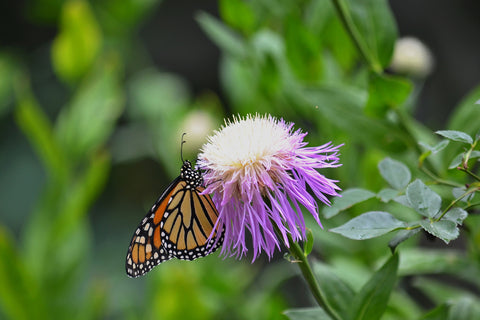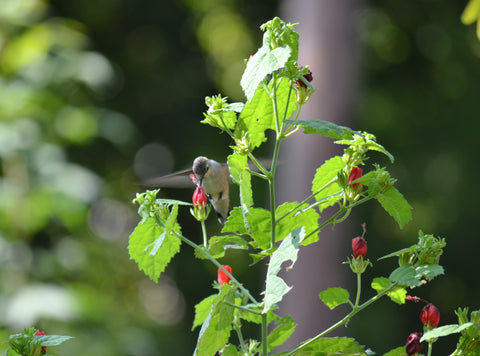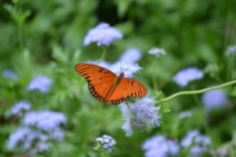Sun Exposure: Giving Your Plants What They Need
October 25, 2018
Successfully introducing a new plant into your garden requires that you get to know each other. And part of that process is finding out how much sun your new plant needs – and what kind of sun.
Your plant may have come with sun exposure guidelines, or you may have found these guidelines by searching online. You may know that the blackfoot daisy does best in full to part sun, while autumn sage can handle both sun and part shade. But what does that mean, exactly, and does it matter?
Yes, it matters. Just ask your plants! They will soon let you know how they feel about the sun exposure they are getting. But to help you provide the best environment possible right from the start, here are five sun exposure terms you should know:
- Full sun: A minimum of six hours of direct, unfiltered sunlight per day.
- Part sun: Between four and six hours of direct, unfiltered sunlight per day, preferably in the morning and early afternoon. “Part sun” plants generally do better in a brighter garden setting.
- Part shade: Between two and four hours of direct, unfiltered sunlight per day. “Part shade” plants should typically be sheltered from later afternoon and evening sun, especially during the summer.
- Dappled sun: Some direct, but mostly filtered sun exposure, such as in a woodland garden where sunlight peeks through the branches and leaves of trees, producing bright shade throughout the day.
- Full shade: Two hours or less of direct sun exposure, preferably in the morning or late afternoon, plus dappled sun throughout the day.
Sun exposure can impact the performance of your plant considerably. Most plants have a difficult time growing in full shade locations that provide no direct sun exposure or dappled sun, such as in the impenetrable shadow of a building or an evergreen tree. Likewise, plants best suited for part shade can quickly scorch in full sun.
Many plants, especially native plants, ask very little of us. As their caretakers, one of our most important jobs is to find out what they need – and do our best to give them their perfect time in the sun.

Butterfly season can be very inspiring to budding and seasoned gardeners alike. How do you attract these and other delicate creatures to your garden? We all know that adult butterflies feed on nectar, and adding nectar plants to your garden is usually the first step to attracting butterflies, but it should not be the only one. Your garden also needs host plants.

What are host plants, and how do they work? Very simply, host plants are the plants on which a butterfly lays its eggs and that caterpillars use as a food source. Like many young ones, these fledgling creatures can be very picky about what they eat. Specific species of butterflies or moths have developed a host relationship with specific plant species – in some cases with only one species – and the caterpillars need those particular plants in order to survive.

The host plant of the Monarch butterfly is milkweed. But there are practically as many host plants as there are winged creatures. If you are looking to attract a particular butterfly species, it’s easy to find out which plants are the hosts for these particular butterflies. To learn more, visit our Resources (there will be a link inserted here) section.
Host plants are a crucial part of the butterfly life cycle. Add them to your garden alongside nectar plants and enjoy the many visitors they will attract!
Plant Focus: Buttonbush, A Delightful Surprise
September 26, 2018
Buttonbush is native to North Texas, and yet it is not widely used in landscaping. It has a reputation for being a high water use plant. While it is true that it prefers moist soils and in fact can live in marsh-like conditions, it is also adaptable and can be quite happy in an average garden. It prefers deeper soils and will appreciate irrigation in the summer. As with most plants, it will need regular irrigation during the first few years to get established, and it should be trained to be watered deeply and infrequently.
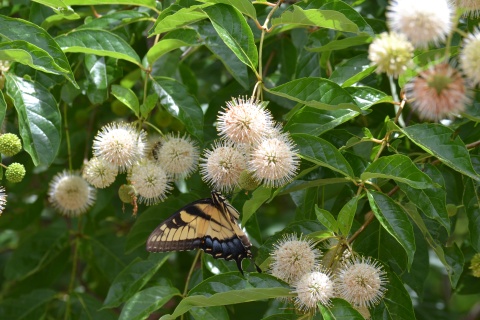
Buttonbush has a graceful growing habit and is a handsome shrub, but can be easily overlooked. That changes around May when it starts blooming. Its flowers are perfectly round creamy puffs that look out of this world. The shrub is covered in blooms for a few weeks and usually buzzing with bee and butterfly activity. It is truly a showstopper during that time.
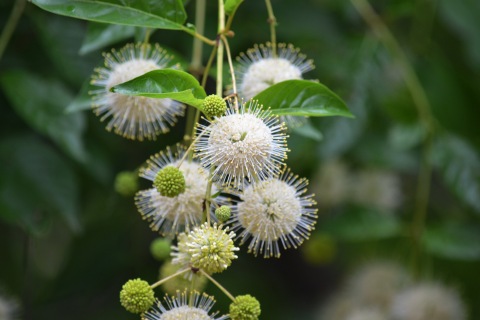
Buttonbush is an excellent choice for low, wet spots in the yard where other things might have a hard time growing. My established buttonbush is thriving in average soil, in full sun and with once a week watering in the summer. Over the years it has grown to be quite an impressive size. Planted as a small 5-gallon shrub 12 years ago, it is now roughly 10 feet tall and 12 feet wide. Do not be afraid to move it if it does not thrive in the original location. Once established, buttonbush is carefree, other than occasional trimming to shape or control size.

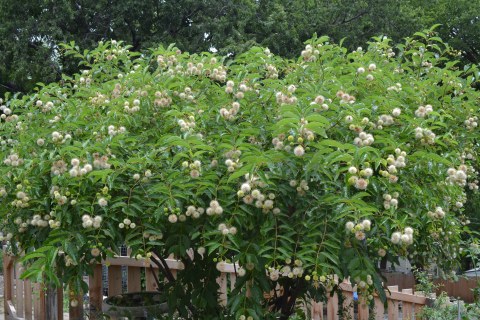
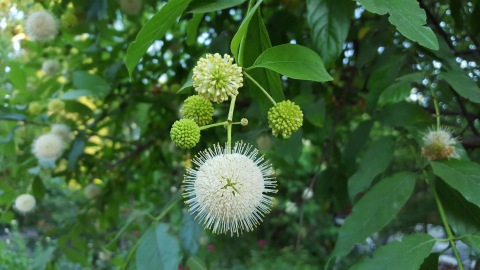

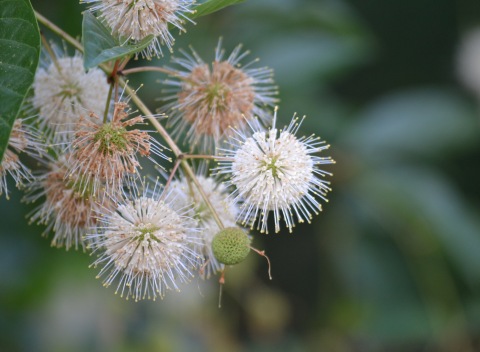
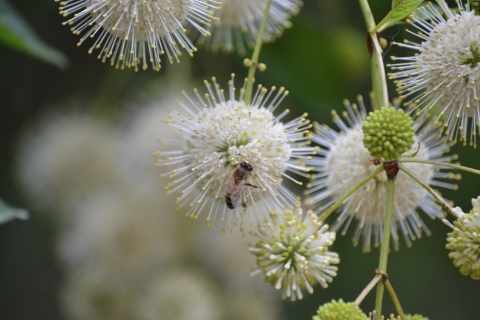
Plant Focus: Tough As A Rock Rose
September 13, 2018
Rock rose does not need much. It is not demanding other than asking for good drainage and some sun. It takes our North Texas weather in strides and laughs in the face of heat and drought. In return for some room in your garden, it will shower you with bright pink flowers that open in the morning and close in the evening.
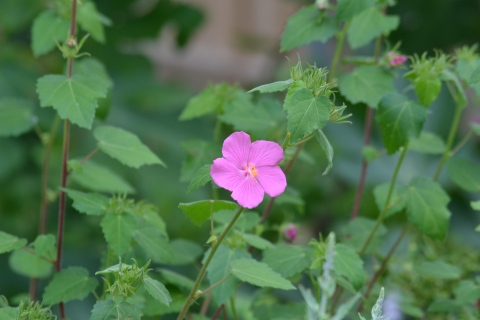
Rock rose has a long flowering period, and it is a workhorse in the garden. It benefits from a haircut a couple of times a year to prevent legginess and woodiness and to keep it more compact. It is a lovely addition to any pollinator garden, prairie or meadow gardens, and fits in well when used as an accent, planted en masse, or used as a taller border plant or lower backdrop in a garden bed.
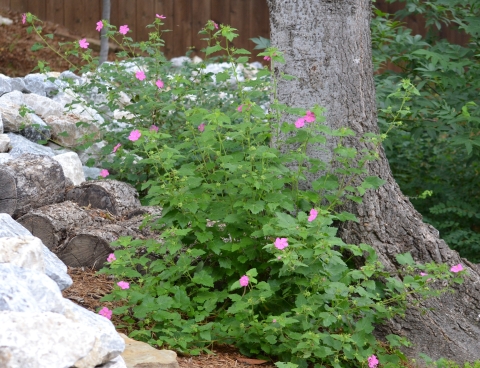

Plant Focus: The Mighty Turk’s Cap
September 6, 2018
If you are going to plant just one native plant in your garden, Turk’s cap should be it. It is a workhorse of a plant that is extremely versatile and perfect for beginners as it is not particular about soil or sun exposure. Turk’s cap needs space as it is quite robust, often 3-4 ft wide and 3-5 ft tall, but the deeper the shade, the smaller it stays. It blooms best in part sun location but will bloom in deep shade as well, just not as profusely.
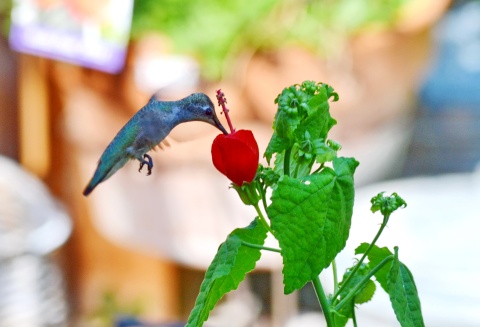
Turk’s cap disappears in the winter but comes back reliably in the spring. From late spring to fall it showers us with lovely bright red blooms that are visited by bees, hummingbirds, butterflies, moths, and it provides shelter and food for birds and other wildlife. Hummingbirds love Turk’s cap and visit it frequently. As a bonus, leaves, flowers, and fruit are edible.
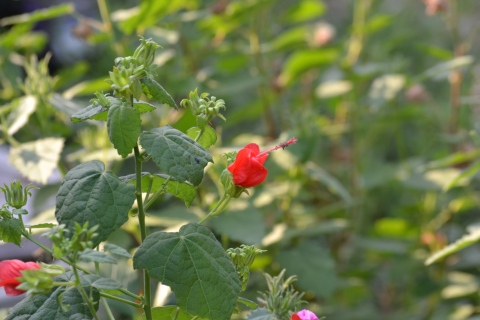
Native Plants: Giving Wildlife a Place to Call Home
September 1, 2018
Thanks to their beauty, vitality, and versatility, native plants are finally enjoying their day in the sun. Native plants occur naturally in a specific geographic region and have evolved to thrive in the conditions of that environment, including the climate and soil. They’re typically more tolerant of drought and stress, they need less water, they’re less prone to disease, and they don’t take as much work. Whether you choose native trees, shrubs, grasses, flowers, or groundcover, native plant species are an important part of any North Texas garden.
Native plants offer another significant benefit: They provide a habitat for wildlife, from mammals to pollinating insects. To put it simply, native plants give wildlife a place to call home.
Rolling out the Welcome Mat for Wildlife
What kind of wildlife are we talking about, exactly? All kinds, including birds, butterflies, bees, amphibians, reptiles, and a range of welcome mammals. Here in North Texas, you may see chickadees, cardinals, mockingbirds, wrens, finches, and dozens of others. You may attract a medley of butterflies, including monarchs, swallowtails, sulphurs, and queens, as well as other essential pollinators such as hummingbirds, native bees, moths, and bats.
And yes, you may attract squirrels, possums, rabbits, and other small mammals, all of which have a place in the garden ecosystem. In fact, the presence of small mammals means that your garden is thriving, and that your insect populations are likely under control. Possums are a great example of the unexpected benefits of garden guests. Our only marsupial, they are harmless, do not carry rabies, and eat ticks by the thousands. Small mammals may even attract larger predators such as hawks, owls, and foxes, indicating that your garden is truly a source of balance in nature.
Native plants are a fundamental component of wildlife habitats. Without extra effort in the garden on our part, these plants naturally provide food and water, nectar, shelter, nesting materials, areas to breed and to raise young, and places to perch, rest, and hide. They yield the ideal fruits, seeds, berries, and nuts to nourish wildlife, as well as attracting other appreciated food sources such as insects, fungi, and lichens. In a nutshell, native plants help wildlife survive in an often inhospitable world.
Wildscaping for Wildlife
Once you’ve gone native in your garden, you’re well on your way to creating a “wildscape.” Wildscaping is the intentional development of natural habitat that attracts wildlife, especially birds and butterflies. Whether it’s in one corner of your backyard or across your entire property, wildscapes provide all the major elements of habitat: food, water, shelter, and space.
Wildscapes have a number of elements in common. They provide natural food sources as well as supplemental food such as a variety of birdseed. And they provide fresh water for drinking and bathing, whether from a small dish, a fountain, a birdbath, or a small pond. Some have nesting boxes for growing families. Some have rock formations for lizards to climb on. Some are fertilized with compost and irrigated with rainwater.
With wildscaping, you’re taking an active part in creating a safe place for wildlife to live, not just to visit. And it can be far more fun and interesting than maintaining a pristine garden. When fall leaves fall, leave some for behind for natural fertilizer. Leave dead trees in place to create small shelters or “snags” that provide cover for critters. Better yet, build your own snags out of logs and branches. Create different layers in your garden with plants of different heights, from groundcover to shrubs to trees. Wildlife will love the playground you’ve constructed.
Most importantly, minimize use of non-native plants, eliminate invasive species, and don’t use insecticides. Making your wildscape an insecticide-free zone only makes sense, as no wildlife habitat is complete without insects. Insecticides are non-selective and will kill beneficial insects along with the unwanted ones. Creating a healthy, balanced wildscape will help control pests naturally while attracting those that wildlife enjoy.
Choosing the Right Native Plants
Even in the extreme and unpredictable climate of North Texas, gardeners have an abundance of native plants to choose from, including hardy deciduous shrubs, ornamental trees, and blooming perennials in a stunning array of colors. To attract the widest range of wildlife, including pollinators, plant an equally wide range of native plants.
For flowering plants in particular, you’ll want to choose plants that yield a variety of colors and fragrances. Keep in mind that plants that bloom at different times of the year will help ensure that your garden is welcoming to wildlife year-round.
Looking for ideas for native Texas plants that wildlife love? Here are some examples of native plants that are easy to grow and wildlife-friendly:
- Agarita – an evergreen shrub that produces small yellow flowers, followed by delicious red berries
- American beautyberry – a perfect understory or woodland garden shrub that yields sparkling magenta berries
- Texas persimmon – a small ornamental tree with edible fruit and attractive exfoliating bark
- Texas sage – a semi-evergreen shrub with silvery grey or green foliage and purple flowers
- Yaupon holly – an evergreen shrub or small tree that produces red berries as well as dense branching and foliage for wildlife nesting and resting
- Turk’s cap – a shrubby perennial with a long blooming season and bright red blooms that are relished by bees, butterflies, and hummingbirds
- Fall aster – a fall-blooming perennial that is an important late-season nectar source, attracting native bees and beneficial insects
- Texas lantana – a shrubby perennial with cheerful yellow and orange blooms that attract pollinators
- Shrubby boneset – a low-maintenance shrub providing late season nectar for pollinators
- Gregg’s mistflower – a butterfly magnet and a must-have in any pollinator garden
Explore other plants here.
A Haven of Hospitality
Native plants have gained popularity as our understanding of the many benefits they offer in the garden grows. Whether you’re a budding gardener or a seasoned professional, consider making at least part of your garden wildlife-friendly. You may soon hear the birds, bees, and other critters thanking you in their own words!
Designing with a purpose.
March 11, 2018
Yes, we like our outdoor spaces to be pretty. But aesthetic is not the end all and be all when it comes to landscape design. So often I see landscapes designed without a purpose. Paths leading to nowhere. Random plant groupings that serve little purpose beyond providing color or evergreen screen. Plenty of missed opportunities and existing issues are either ignored or covered up.
There are many layers to consider when planning your garden.
Combine the aesthetic value, plants’ sun, and water needs, wildlife value, practical purpose (need for drainage, erosion, screen, kids play areas, etc.) and prioritize from there.
In this example (photo below) there was a need to control soil erosion and water flow, hence the dry creek bed. There was strong desire to provide wildlife-friendly habitat, hence the variety of native and well-adapted ground covers, grasses, perennials, shrubs, and trees. And finally, the plant choice was based not only on aesthetic value, but also whether they will be able to thrive in the native soil, handle the sun exposure and moisture available to them, and their wildlife value.
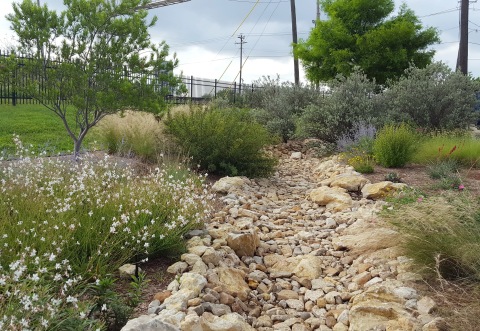
Garden should be an artistic expression of your own individual style. There should be a thought behind it. But it is important that it is also a joyful experience not only for the person giving it life, but also people that will experience it as guests. Landscapes are not meant to be static. They are alive and ever changing. And if the design has a clear structure and purpose, no matter how natural looking it may be, it will be much easier to maintain.
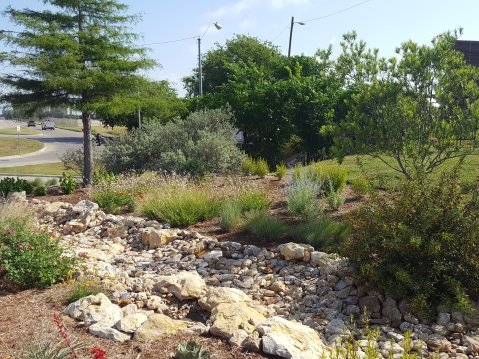
Fall is for fun.
November 8, 2017
Fall is such a fun season in North Texas. The temperatures are mostly mild; it actually feels nice to be outside. It is the best season for planting. The need for watering is much less than in the summer. And to make it even better, it is a great time to be outside observing wildlife. Pollinator activity is high, and who needs TV when you have wildlife.
While watching all the activity going on in your garden, you may want to delve into the world of plant and animal identification. There are many tools available to make identification easy these days. Internet searches bring a treasure trove of information, and I find a few sites to be particularly helpful when trying to find plant and wildlife-related information.
Lady Bird Johnson Wildflower Center’s website provides a wealth of information and is very useful in research of native plants and the role they play in our ecosystem. www.wildflower.org
Butterflies and Moths of North America (BAMONA) is an effort to collect, store, and share species information and occurrence data. It is also a great butterfly and moth identification tool. You can find information on the website as well as post your sighting for identification. www.butterfliesandmoths.org
iNaturalist is “a place where you can record what you see in nature, meet other nature lovers, and learn about the natural world”. It is a powerful identification tool for both fauna and flora. www.inaturalist.org
Have fun discovering all that is around you.
Butterfly gardening
October 17, 2017
Butterfly gardening is easy and rewarding. All it takes is providing a few simple things that butterflies (and generally speaking all pollinators) need: nectar and host plants, shelter and water.
Here are a few simple steps to help all the pollinators in your garden:
- Do not use pesticides. Organic is the way to go when if you want to create a wildlife habitat of any sort. Organic pesticides still kill, so use judiciously, locally and only if you have a real problem. Nature has a way of sorting itself out and after a year or two of doing things organically, you will notice a balance in your garden that will rarely require your intervention.
- Plant nectar and host plants. Choose plants native to the area whenever possible. Here are some sources of information on native and well-adapted plants for North Texas : Happy Gardens Plant Library , Lady Bird Johnson Wildflower Center , Butterfly Gardening , Texas Native Society , Texas Parks and Wildlife
- Choose a sunny spot for your butterfly garden. Butterflies love warm and sunny areas as they are cold blooded and need to be able to warm up.
- Provide a source of water. A shallow dish with just barely any water in the bottom and some flat rocks throughout would serve both as a water source and a spot where the butterflies can soak in the sun. You can add over-ripe fruit for their benefit as well.
- Choose a somewhat sheltered spot for your butterfly garden to protect them from the wind.
- Butterflies prefer plant groupings to singular plants.
And… enjoy! Watching life in the garden is a source of constant joy.
Plan for the spring.
January 19, 2013
Spring is such an enjoyable part of the year. Nature is exploding with new growth, buds, flowers… Gardens come to life again. Birds are in love and ready to start a family. Landscapes become abuzz with life and related activity. It’s also the time of year when things get out of hand pretty quickly. Weeds seek their opportunity to take over the world. Plants hurry to grow and multiply – often ending up in the wrong places, overgrown, reseeding everywhere, out of place. It also means our gardens are hungry – they  need the energy to grow, bloom and produce. Winter takes its toll on our landscapes, and spring is the time to make it right again.
need the energy to grow, bloom and produce. Winter takes its toll on our landscapes, and spring is the time to make it right again.
The best way to maintain a landscape is to do it regularly, and not wait until things are out of control. Proper trimming and pruning, weed control, amending, feeding, mulching, insect and disease control go a long way when done right and on time. It is easier to prevent problems or nip them in the bud when they arise, then to put out fires.
When thinking about your garden, think about its foundations– soil and balance. If you nurture the soil, it will repay you with happy plants. And happy, strong plants are more resilient, more beautiful, more drought tolerant and better adapted to the Texas heat. Healthy soil means healthy plants. And healthy plants mean less disease and insect problems. Creating a balanced ecosystem in your garden is the key to success. Nature has a way of taking care of its own problems. Plus, a garden alive with plants and wildlife is such a beautiful place to be and enjoy. It is also a great way for the children to reconnect with the outdoors. Provide butterfly food and host source and let them observe a butterfly emerge from its chrysalis. Add plants that attract hummingbirds and watch them come back year after year. Start an herb garden and let the kids be hands on. They can pick their own favorite herbs or veggies to grow. 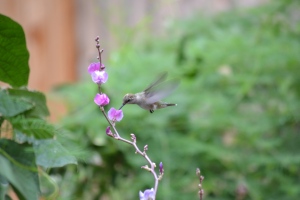 Provide shelter for lizards, geckos, and other garden creatures and teach your kids that variety and balance is very important in nature. And in return, they will help you keep your insect (including mosquito!) population in check.
Provide shelter for lizards, geckos, and other garden creatures and teach your kids that variety and balance is very important in nature. And in return, they will help you keep your insect (including mosquito!) population in check.
There are so many ways to you enjoy your garden. The same outdoor space can provide the perfect entertaining area for the adults and a secret garden, full of wonder and life lessons for the kids. No matter how small or big your piece of land is, you can make it work for everyone.

